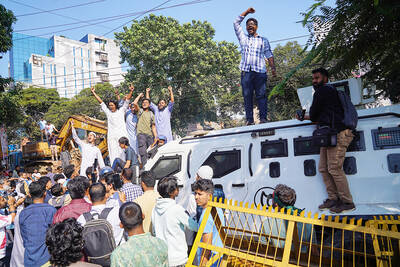Muhammad Hussein was always the baby of the family. His hero was an Iraqi soccer player. He liked Indian cinema. With his brothers already grown, he spent a lot of time alone.
But earlier this year, to his family's consternation, Hussein decided to join the Mahdi Army, the militia led by Muqtada al-Sadr, the rebel Shiite cleric now under siege by American and Iraqi forces in Najaf, the holy Shiite city south of Baghdad. With a rag-tag band of boys from his neighborhood, Hussein stood guard against American soldiers in the trash-strewn streets of Sadr City, a sprawling Shiite slum.

PHOTO: NY TIMES
Then, on a stifling day in June, Hussein was shot dead across from his family's house while firing at American and Iraqi forces near a police station. He was 19.
"The pain inside me," said his brother Adnan Hussein, bringing his hand to his face. "We tried so hard not to let him go with them."
Along with the fighting that has raged this week in Najaf and other Iraqi cities, there is a debate about the dedication and effectiveness of the Mahdi Army fighters. The story of Muhammad Hussein casts light on that question, as well as on the new threat that he and other young, disaffected men like him pose to the American presence and the interim government of Prime Minister Ayad Allawi.
They are a lost generation, young people who grew up during Iraq's decline into war and economic sanctions over the past 20 years. But they not a homogeneous group. Their reasons for fighting often have more to do with their poverty and a desire to belong than with any strongly held beliefs about religion or nationalism.
Al-Sadr has stepped in to fill the void. He speaks forcefully against the American occupation in a way that appeals to many dispossessed Shiites, and draws on the martyrdom of his father, a revered cleric who was killed in the 1990s by the government of Saddam Hussein.
"He's not afraid of anyone," said Ayam Muhammad, 19, a Sadr City resident who says she is part of a Mahdi Army women's brigade, a group that works with the militia. "He made a revolution against Saddam Hussein."
Muhammad Hussein, a Shiite, was born in 1985, five years into Iraq's war with Iran, at a time when Saddam Hussein was tightening his brutal grip on society.
He lived through the crippling economic sanctions that were imposed in 1991 and maintained until the 2003 US-led invasion. This led to a deepening of poverty in areas like Sadr City and the rise of a younger generation that was less educated and had fewer opportunities than the one before it.
Muhammad Hussein's family was not destitute. Even so, Hussein had never owned a telephone, never been on an airplane, never been abroad. He had finished only seven years of school. In contrast, his brothers, ages 48 and 56, have secondary degrees, one in music and another in mechanical engineering. One has traveled abroad and speaks a foreign language.
"He was the odd one in the family," said Adnan Hussein, 48, who works as a lute instructor.
When the Americans invaded last March, Muhammad Hussein was packing cigarettes in a factory. His brother said the teenager's friends were poor, and many had lost family members in the war.
"Most of his friends were thieves," Adnan Hussein said. "They pretended they were religious, but inside of them they were very far from that."
After the US invasion, he joined his friends in the looting, and one day brought a load of furniture and guns to his family's cramped apartment. His father was furious, and ordered him to take everything back, but Hussein refused.
Then, over the winter, he stopped eating at home. He started carrying a weapon. And he began attending a mosque. His opinion of the American occupation hard-ened, and he started calling himself a Mahdi fighter.
His father tried punishing him, and once kicked him out of the house. His brother begged him to stay indoors. But he was killed 10 days later, leaving the question of why he was willing to risk his life.
Many Iraqis, even those sympathetic to the insurgency, dismiss the Mahdi fighters as thugs.
"They are not an army," said Yahya al-Obaidi, 33, a Sunni shop owner in Baghdad, where Mahdi fighters staged an attack on Tuesday. "They're just a bunch of dis-organized men."
Adnan Hussein said his brother was "a brick in the wall" of other young men looking for meaning in their lives.
In contrast to the Sunni fighters of Fallujah, who are bound by a fierce patriotism and Arab nationalism, the Mahdi militia members seem to fight more out of personal loyalty to Al-Sadr. Muhammad said she backs Al-Sadr because he "wants to be useful to the poor people who have suffered so much."
Residents of other Baghdad neighborhoods say that easy-to-get jobs would deflate much of the fervor that has built up around Al-Sadr. The cleric seemed to acknowledge as much when he told mediators in private talks last week that he was ready for his army to be used as a type of "social organization" for public works projects, and not for fighting.
In the home of Muhammad Hussein, though, the grief is still fresh. The television has not been turned on since Hussein died. His father, 77, most days does not get out of bed. His brother Adnan is looking for a way to take his lutes and teaching to Syria.
He is still trying to understand his brother's choice.
"It was his own world," he said. "It was wrong. But there was something inside him that needed it."

DISASTER: The Bangladesh Meteorological Department recorded a magnitude 5.7 and tremors reached as far as Kolkata, India, more than 300km away from the epicenter A powerful earthquake struck Bangladesh yesterday outside the crowded capital, Dhaka, killing at least five people and injuring about a hundred, the government said. The magnitude 5.5 quake struck at 10:38am near Narsingdi, Bangladesh, about 33km from Dhaka, the US Geological Survey (USGS) said. The earthquake sparked fear and chaos with many in the Muslim-majority nation of 170 million people at home on their day off. AFP reporters in Dhaka said they saw people weeping in the streets while others appeared shocked. Bangladesh Interim Leader Muhammad Yunus expressed his “deep shock and sorrow over the news of casualties in various districts.” At least five people,

LEFT AND RIGHT: Battling anti-incumbent, anticommunist sentiment, Jeanette Jara had a precarious lead over far-right Jose Antonio Kast as they look to the Dec. 14 run Leftist candidate Jeannette Jara and far-right leader Jose Antonio Kast are to go head-to-head in Chile’s presidential runoff after topping Sunday’s first round of voting in an election dominated by fears of violent crime. With 99 percent of the results counted, Jara, a 51-year-old communist running on behalf of an eight-party coalition, won 26.85 percent, compared with 23.93 percent for Kast, the Servel electoral service said. The election was dominated by deep concern over a surge in murders, kidnappings and extortion widely blamed on foreign crime gangs. Kast, 59, has vowed to build walls, fences and trenches along Chile’s border with Bolivia to

DEATH SENTENCE: The ousted leader said she was willing to attend a fresh trial outside Bangladesh where the ruling would not be a ‘foregone conclusion’ Bangladesh’s fugitive former prime minister Sheikh Hasina yesterday called the guilty verdict and death sentence in her crimes against humanity trial “biased and politically motivated.” Hasina, 78, defied court orders that she return from India to attend her trial about whether she ordered a deadly crackdown against the student-led uprising that ousted her. She was found guilty and sentenced to death earlier yesterday. “The verdicts announced against me have been made by a rigged tribunal established and presided over by an unelected government with no democratic mandate,” Hasina said in a statement issued from hiding in India. “They are biased and politically motivated,” she

It is one of the world’s most famous unsolved codes whose answer could sell for a fortune — but two US friends say they have already found the secret hidden by Kryptos. The S-shaped copper sculpture has baffled cryptography enthusiasts since its 1990 installation on the grounds of the CIA headquarters in Virginia, with three of its four messages deciphered so far. Yet K4, the final passage, has kept codebreakers scratching their heads. Sculptor Jim Sanborn, 80, has been so overwhelmed by guesses that he started charging US$50 for each response. Sanborn in August announced he would auction the 97-character solution to K4